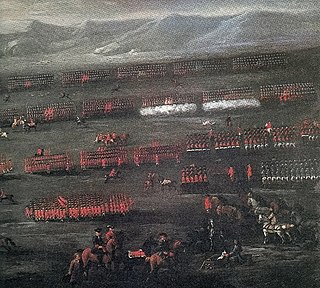Related Research Articles
The Stewart, later Shaw-Stewart Baronetcy, of Greenock and Blackhall in the County of Renfrew, is a title in the Baronetage of Nova Scotia. It was created on 27 March 1667 for Archibald Stewart. In Scotland, the name is styled Shaw Stewart.
Kincardineshire was a constituency represented in the Parliament of Scotland until 1707.
Wigtownshire was a constituency represented in the Parliament of Scotland until 1707.
Before the Act of Union 1707, the barons of the constabulary of Haddington elected commissioners to represent them in the unicameral Parliament of Scotland and in the Convention of Estates. The number of commissioners was increased from two to four in 1690.
Before the Act of Union 1707, the barons of the sheriffdom or shire of Dumfries and the stewartry of Annandale elected commissioners to represent them in the unicameral Parliament of Scotland and in the Convention of Estates. The number of commissioners was increased from two to four in 1690.
Before the Act of Union 1707, the barons of the sheriffdom or shire of Berwick elected commissioners to represent them in the unicameral Parliament of Scotland and in the Convention of Estates. The number of commissioners was increased from two to four in 1690.
Sutherland was a constituency that returned shire commissioners to the Parliament of Scotland and to the Convention of the Estates.
Before the Act of Union 1707, the barons of the shire or stewartry of Kirkcudbright elected commissioners to represent them in the unicameral Parliament of Scotland and in the Convention of Estates. The number of commissioners was increased from one to two in 1690.
North Berwick in Haddingtonshire was a royal burgh that returned one commissioner to the Parliament of Scotland and to the Convention of Estates.
Before the Acts of Union 1707, the barons of the shire of Elgin and Forres elected commissioners to represent them in the unicameral Parliament of Scotland and in the Convention of the Estates.
Before the Acts of Union 1707, the barons of the shire or sheriffdom of Argyll elected commissioners to represent them in the unicameral Parliament of Scotland and in the Convention of the Estates. The number of commissioners was increased from two to three in 1693.
Before the Acts of Union 1707, the barons of the shire of Stirling elected commissioners to represent them in the unicameral Parliament of Scotland and in the Convention of the Estates.
Before the Acts of Union 1707, the barons of the shire of Roxburgh elected commissioners to represent them in the unicameral Parliament of Scotland and in the Convention of the Estates. The number of commissioners was increased from two to four in 1690.
Before the Acts of Union 1707, the barons of the shire of Aberdeen elected commissioners to represent them in the unicameral Parliament of Scotland and in the Convention of the Estates. The number of commissioners was increased from two to four in 1690.
Before the Acts of Union 1707, the barons of the shire of Linlithgow elected commissioners to represent them in the unicameral Parliament of Scotland and in the Convention of the Estates.
Before the Acts of Union 1707, the barons of the shire of Dumbarton elected commissioners to represent them in the unicameral Parliament of Scotland and in the Convention of the Estates.
Before the Acts of Union 1707, the barons of the shire of Peebles elected commissioners to represent them in the unicameral Parliament of Scotland and in the Convention of the Estates.
Before the Acts of Union 1707, the barons of the shire of Perth elected commissioners to represent them in the unicameral Parliament of Scotland and in the Convention of the Estates. The number of commissioners was increased from two to four in 1690.
Marie Lamont, also referred to as Mary Lawmont (1646–1662), was executed for witchcraft during the reign of Charles II just after Witchmania had peaked in the United Kingdom. Her youth at the time of her execution made her case unusual.

Sir John Shaw, 3rd Baronet of Greenock was a Scottish Whig politician who sat in the House of Commons between 1708 and 1734. He was instrumental in the construction of Greenock Harbour, and took part in actions against the Jacobite risings.
References
M. D. Young, The Parliaments of Scotland: Burgh and Shire Commissioners (1993) vol. II, p. 798.
- 1 2 3 G. E. C., The Complete Baronetage, vol. iv (1904) p. 268.
- 1 2 3 Joseph Foster, Members of Parliament, Scotland (1882) p. 189.
- 1 2 Complete Baronetage, vol. iv, p. 350.
- 1 2 Members of Parliament, Scotland, p. 313.
- 1 2 Complete Baronetage, vol. iv, p. 261.
- ↑ Complete Baronetage, vol. iv, p. 267.
- ↑ Parliamentary Papers, Volume 62, Part 2. pp. 585, 588.
- ↑ Complete Baronetage, vol. iv, pp. 312–313.
- 1 2 3 Parliamentary Papers, Volume 62, Part 2. p. 596.
- ↑ Complete Baronetage, vol. iv, p. 416.